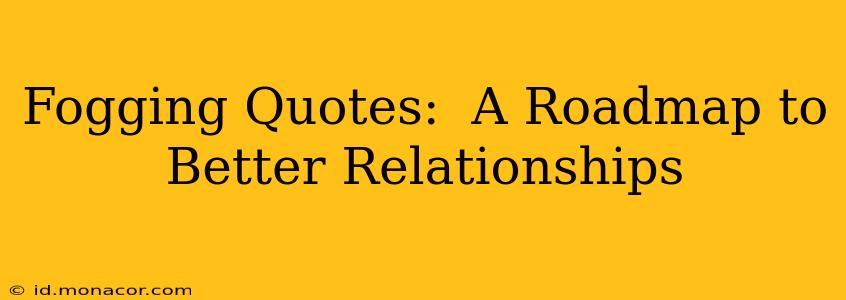Fogging, a communication technique rooted in assertive communication, involves acknowledging the validity of another person's perspective without necessarily agreeing with it. It's a powerful tool for de-escalating conflict and improving relationships, both personal and professional. Think of it as a gentle mist, softening the sharp edges of disagreement rather than creating a full-blown storm. This article explores fogging quotes and how they can be effectively utilized to navigate challenging conversations and build stronger bonds.
What is Fogging, and Why Use It?
Fogging is a communication skill that involves acknowledging the other person's perspective without necessarily agreeing with it or justifying your own. It’s a way to diffuse conflict by avoiding argument and defensiveness. Instead of reacting emotionally, you acknowledge the other person's feelings and experiences. This approach demonstrates respect and understanding, which can help de-escalate tense situations and foster a more positive environment for communication.
Why is fogging so effective? Because it validates the other person's feelings without triggering a defensive response. By acknowledging their perspective, you show empathy and understanding, making them more receptive to your own point of view. This, in turn, opens up space for constructive dialogue and problem-solving.
Examples of Fogging Quotes in Action
Instead of directly refuting a statement, fogging utilizes phrases that acknowledge the other person's statement without explicitly agreeing or disagreeing. Here are some examples:
- "That's one way of looking at it." This simple phrase acknowledges the other person's perspective without committing to its validity.
- "You seem to feel strongly about this." This focuses on the other person's emotions, showing empathy and understanding.
- "I can see why you'd feel that way." This shows that you understand their reasoning, even if you don't agree with their conclusion.
- "I understand your concern." This acknowledges their worry or apprehension, fostering trust.
- "It's interesting how you see it that way." This expresses curiosity without judgment, promoting openness.
How to Effectively Use Fogging in Conversations
The key to using fogging effectively is to remain calm and neutral. Avoid becoming defensive or argumentative. Here's a step-by-step guide:
- Listen attentively: Before responding, actively listen to what the other person is saying. Pay attention not only to their words but also to their body language and tone of voice.
- Identify the emotion: Try to identify the underlying emotion driving their statement. Are they angry, frustrated, hurt, or anxious?
- Acknowledge their perspective: Use a fogging quote to acknowledge their feelings and perspective. For instance, "I understand your frustration." or "I can see why you feel that way."
- Avoid argumentation: Refrain from arguing or debating. The goal is to de-escalate the situation, not to win an argument.
- State your own perspective (if needed): After acknowledging their perspective, you can calmly and clearly state your own, without directly contradicting theirs.
Addressing Common Concerns about Fogging
H2: Doesn't fogging make you seem weak or passive?
No. Fogging is not about being passive or giving in. It's about assertive communication. You're acknowledging the other person's feelings without sacrificing your own needs or beliefs. It's a strategy for managing conflict constructively, not avoiding it.
H2: How do I use fogging when someone is being aggressive or unreasonable?
While fogging is most effective in less heated situations, it can still be useful in more challenging interactions. Focus on acknowledging their emotions ("I can see you're very angry.") before attempting to de-escalate. If the situation becomes unsafe, it's important to disengage and seek support.
H2: Can fogging be used in all types of relationships?
Yes, fogging is applicable in various relationships – romantic partners, family members, friends, colleagues, and even strangers. Its adaptability makes it a valuable communication tool in diverse contexts.
Conclusion: Fogging as a Foundation for Strong Relationships
Mastering the art of fogging can significantly enhance your relationships. By acknowledging others' perspectives without sacrificing your own, you create a space for understanding, empathy, and constructive dialogue. While it may take practice, the rewards of improved communication and stronger, healthier relationships are well worth the effort. Remember, fogging is a powerful tool for navigating conflict, not avoiding it, and ultimately building a more peaceful and understanding world.

